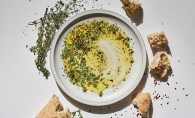As Minnesotans, there are certain foods that we can claim as a birthright, traditional recipes that define the 32nd state with button-bursting pride, as well as a heaping side dish of mockery. Hotdish anyone? Maybe a slab of lutefisk?
Beyond the jokes about green Jell-O salad with pineapple and carrots, the Land of 10,000 Lakes boasts a deep and incredibly diverse food culture. From the north woods to the sweeping southern prairies, Minnesota home cooks create foods steeped in tradition. For holiday gatherings and milestone events, trusted recipes are brought forth, either from memory or hand-written cards worn thin with time. We produce the foods and sustenance that’s been handed down through generations.
Teresa Marrone’s newest cookbook, Dishing Up Minnesota, (available at Barnes and Noble) traverses the state and includes stories of its most beloved recipes and traditions, over hundreds of miles and as many individuals. Marrone hunkered down in the kitchens of Minnesota homes to learn what it means to eat the traditional foods that characterize our state. With an already impressive resume of published titles, Marrone goes beyond glittering restaurants and celebrated chefs and asks the question, “What are the foods that truly identify Minnesota?”
“I’ve always been interested in food,” explains Marrone. “And ever since I was a child, I have explored all manner of food, reading cookbooks like they’re novels.”
Dishing Up Minnesota is part of the Dishing Up series presented by Storey Publishing, highlighting the food that defines each state, and is the first Midwest book in the series. In Marrone’s personal journey to learn of the types of foods that characterize Minnesota, she became frustrated after an article published in the New York Times in 2014 named a grape salad as a time-honored Thanksgiving dish of Minnesota.
“No one even knew what grape salad was, nor had anyone even eaten it,” she says. The social media storm following the article revealed an intense discussion of the foods that represented Minnesota, and the multiple cultures that make their home here.
“Really, it all began with Native American foods and evolved through our outdoorsy lifestyle. We hunt, we forage and we fish, but even in utilizing the same ingredients, the end results often vary widely,” Marrone explains. “There can be two families in neighboring towns that make lefse from a family recipe that can taste very different, but both of them are accurate. There isn’t just one way to make one type of food.”
As the cultural face of Minnesota changes, so do the foods that become beloved. The state’s most populous groups of European settlers include Germans and peoples from Nordic states, primarily Norway and Sweden. But with everything from Irish, English, Polish, French, Italian, and now an expansive Hmong, Vietnamese, Hispanic and Somali influence, what can be described as truly Minnesotan is constantly changing.
Drawing together not only the traditional foods that our home cooks create, Dishing Up Minnesota also highlights many of the locally produced artisan foods from Minnesota purveyors that are quickly becoming household names for food lovers.
For example, our state is home to many beekeepers, and honey from a Minnesota beehive can take on many flavor characteristics, due to the concept of terroir, where a food grown in a certain climate and soil incorporates aspects of that climate into its taste profile. One local beekeeper, David Donatelle, provided a recipe reminiscent of his Italian descent to Dishing Up Minnesota, using honey from bees he tends in his own backyard. Donatelle is director of dining services at Sunrise Assisted Living in Edina. He and his wife Joan have shared their love of Mediterranean cuisine throughout the food community of Minnesota, teaching private classes and leading food-centric excursions to Italy.
“The honey-spiced chicken tagine is a fantastic recipe, highly nutritious, with a complex taste profile.” Donatelle explains. “We have always been intrigued with healthy, natural, scratch-made food. And we love to share that knowledge any way we can.”
From Dishing Up Minnesota: Honey-Spiced Chicken Tagine
4–6 servings
- 2 Tbsp. extra-virgin olive oil
- 6 bone-in, skin-on chicken thighs
- 1 yellow onion, thinly sliced
- 1 orange-fleshed sweet potato, peeled and cut into ½-inch cubes
- 2 garlic cloves, minced
- 1 Tbsp. minced fresh ginger root
- ½ tsp. red pepper flakes
- ½ tsp. ground turmeric
- ½ tsp. sea salt
- ¼ tsp. ground cinnamon
- 1 cup chicken broth
- ¼ cup honey
- 2 Tbsp. lime juice
- 1 Tbsp. red wine vinegar
- 1 10-ounce package couscous, prepared according to package directions
- ½ cup chopped fresh cilantro
- 2 Tbsp. chopped almonds
- 2 Tbsp. golden raisins
- 1 lime, cut into wedges
1. Heat the oven to 325 degrees F. Heat the oil in a tagine or Dutch oven over medium-high heat. Add the chicken and brown on both sides, about 10 minutes. Transfer to a plate. Add the onion, sweet potato, garlic, and ginger root to the tagine. Cook, stirring occasionally, for about 5 minutes. Stir the pepper flakes, turmeric, salt and cinnamon together in a small bowl. Sprinkle over the onion mixture, stirring to combine.
2. Measure the broth in a 2-cup measuring cup. Pour the honey into the measuring cup and stir in the lime juice and vinegar. Return the chicken to the tagine. Pour the broth mixture over the chicken. Cover and bake for 1 hour.
3. To serve, spread the hot cooked couscous in a wide serving dish. Spoon the chicken and sauce over the couscous. Top with the cilantro, almonds and raisins, then tuck the lime wedges around the sides. Serve immediately.









